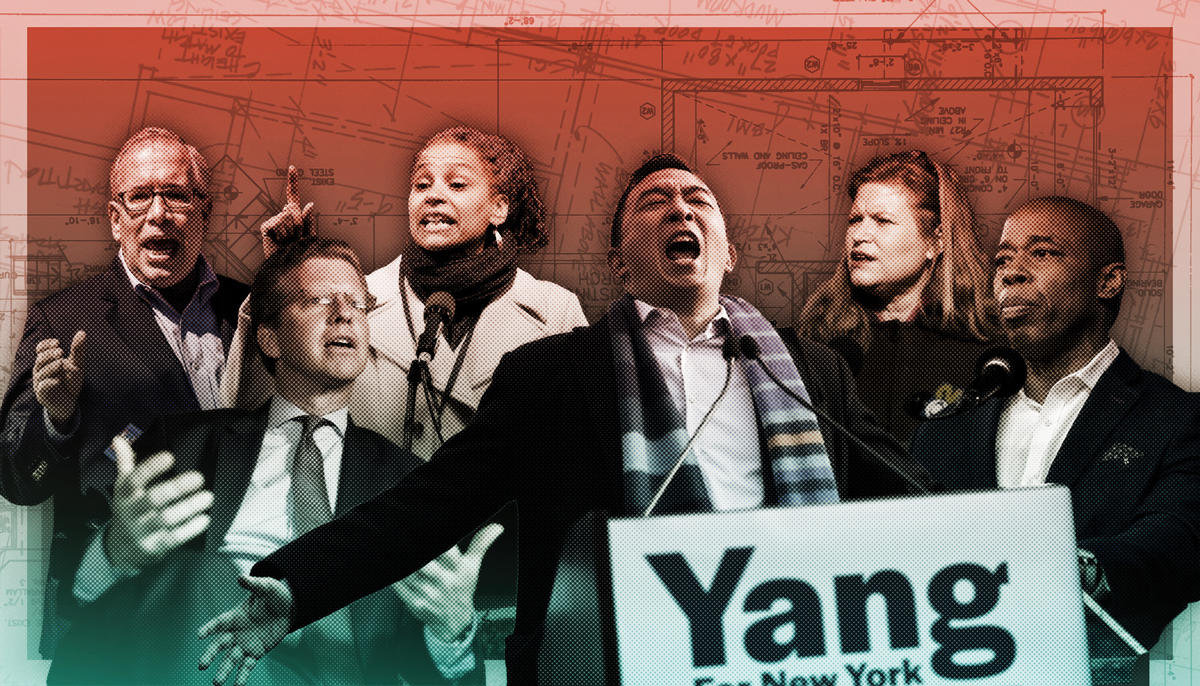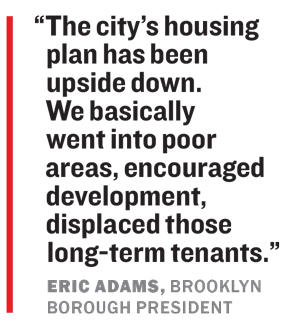Trending
Where mayoral candidates stand on real estate
Differences emerge on industry donations, housing policy, taxes

As more candidates join the New York City mayoral race, they threaten to hit a critical threshold: how many fit on a Zoom screen.
With just four months until the Democratic primary that is sure to determine the winner, candidates have been facing off in adjacent squares like an extended Brady family. More than 40 are running, and given New York’s progressive electorate, their overlap on positions is considerable — notably in their distancing themselves from the unpopular Mayor Bill de Blasio.
But on real estate issues, differences emerge. Contenders including Comptroller Scott Stringer have derided developers’ tax breaks and refused their money, while others have condemned demonization of the industry.
“The real estate community is part of New York,” said Brooklyn Borough President Eric Adams. “We’re going to need them just like we needed them in the 1970s. Just like we needed them after 9/11. Just like we needed them after the financial crisis of 2008.”
Many have lambasted de Blasio’s affordable housing program, taken up the debate over land use and picked up on calls to shift city-backed apartment projects to nonprofits.
The remote nature of this mayoral race isn’t the only thing that sets it apart. The next mayor will inherit a city devastated by the pandemic. Facing budget deficits in the billions of dollars, city officials could ask the state to raise taxes on the industry and its top customers.
“The city’s budget problems either go through Albany, or they go through a very painful reckoning on spending and property taxes,” said Evan Stavisky, a partner at the Parkside Group, a political consulting firm. “There are real challenges there.”
Allies and enemies
Among the top eight candidates, several could be seen as allies by real estate.
Adams, a former New York City police captain, is one. Ray McGuire, a former vice chairman at Citigroup, speaks the industry’s language, boasting more than 30 years of business experience. And Shaun Donovan was the top housing official for real estate-friendly Mayor Michael Bloomberg before serving as President Barack Obama’s secretary of Housing and Urban Development.
Though Stringer and former city sanitation commissioner Kathryn Garcia have criticized tax breaks beloved by developers, they are considered moderates. Real Estate Board of New York president James Whelan recently brushed off Stringer’s anti-developer rhetoric, saying the longtime establishment figure was just in “campaign mode.”
 Further to the left are attorney and civil rights activist Maya Wiley, former presidential candidate Andrew Yang, Brooklyn Council member Carlos Menchaca and nonprofit executive Dianne Morales.
Further to the left are attorney and civil rights activist Maya Wiley, former presidential candidate Andrew Yang, Brooklyn Council member Carlos Menchaca and nonprofit executive Dianne Morales.
Developers Stephen Ross and Jack Cayre have poured money into a campaign fund focused on keeping antagonists of the industry out of the City Council. But in the mayoral contest, real estate executives have donated liberally to Adams, Donovan, McGuire and Stringer, before the comptroller began turning down their checks a year ago. The donation strategy is designed to curry favor with whoever wins.
“In the mayoral race, the calculus is different,” said Neal Kwatra, CEO of political consulting firm Metropolitan Public Strategies. “If you lose, you risk alienating the person who does end up emerging.”
Beating up on MIH
Many mayoral hopefuls have deemed de Blasio’s Mandatory Inclusionary Housing a failure, albeit well-intentioned. The program requires developers to set aside a percentage of apartments as permanently affordable if a project benefits from rezoning.
Only six of the 15 neighborhood rezonings de Blasio planned have been approved. But the candidates’ main criticism has been that the “affordable” units’ rents are too high and that the rezonings have only been in communities of color.
“Our housing plan has been upside down,” Adams said. “We basically went into poor areas, encouraged development, displaced those long-term tenants.”
That critique has been common among candidates, despite city planners’ insistence that rezonings slow displacement by providing housing for new arrivals.
Most of the candidates, however, support the mayor’s belated push to rezone high-income Soho. Adams said other areas of Manhattan are ripe for rezoning as well.
Stringer was the first to lay out in detail how he would replace MIH. His “universal affordable housing” program would mandate that all new residential construction with 10 or more units set aside at least 25 percent of apartments as affordable with rents at an average of 60 percent of the area median income.
He would focus rezonings on “high-opportunity neighborhoods [with] the ability to add density without displacing existing affordable housing.”
“The failure of MIH is to assume only a few low-income neighborhoods should bear the brunt of providing affordable housing,” Stringer said in a statement.
Alicia Glen, who oversaw the program as deputy mayor, noted that it is “popular” for candidates to criticize the outgoing mayor.
“I think some candidates clearly don’t understand the mechanism and the legality of how you structure MIH,” said Glen, who now runs her own development firm, MSquared. “The bottom line is, the policy that we put together works.”
Of Stringer’s heavy mandates, she said, “That would be illegal, and he knows better.”
Garcia has said she would create 50,000 affordable units for households making less than 30 percent of the area median income — 20,000 more than de Blasio has.
Donovan would not mandate inclusionary housing citywide, like Stringer, but would use “robust incentives” to encourage mixed-income projects with “deep affordability.”
But he doesn’t think that should be a singular pursuit.
“One of the problems under this administration is that inclusionary zoning has become too much of a focus of our affordable housing policy,” Donovan said. “And it is not a silver bullet.”
Zone defense
In addition to rezoning higher-income neighborhoods, candidates have called for an overhaul of the seven-month land-use review process. The City Council is also considering requiring a racial impact study for major rezonings.
Late last year, Council Speaker Corey Johnson proposed a 10-year, citywide planning framework. It would set long-term goals for housing, transportation, public space and other needs and make Council approval of rezonings optional. Persuading members to give up that power would be difficult, especially with Johnson opting out of the mayoral race last year.
One Council member who is running, Menchaca, supports Johnson’s plan, though he thinks it could go further. He said the trajectory of Industry City’s rezoning application, which was withdrawn last year because of his opposition, underscores the importance of community engagement in advance.
After numerous meetings with community members and fruitless talks with Menchaca, the campus’s owners went ahead with their application but could not come to terms with the Council member, who faced intense pressure from local activists.
De Blasio remained on the sidelines, calling it a City Council matter. He was chastised by business groups for not helping a proposal that promised thousands of jobs and $1 billion in investment and by Menchaca for not sweetening the deal with community benefits.
Menchaca said mayors need to be more involved to ensure rezonings’ benefits don’t primarily go to developers.
“They essentially get what they want, and we get essentially bite sizes of what the public needs,” Menchaca said. “We’re [granting] massive amounts of zoning rights for a fraction of what we could be getting in terms of affordability.”
He added that rezonings slated for completion before the end of de Blasio’s term, including of Soho and Gowanus, should be halted until the process is changed.
Several candidates have pointed to the need for deeper community involvement in the process, though no one has pitched a wholesale replacement. Adams called for a balance between community involvement and the city’s ability to grow.
“If you have too many cooks in the kitchen, we’re going to spoil the broth,” Adams said. “The reality is that some residents don’t want any type of development at all.”
Private vs. public
Mayoral contenders have tapped into several discussions about curbing for-profit development.
Several have promoted eliminating or reforming the tax break Affordable New York, the successor to 421a — a decision that rests with the state but which mayors can influence. Developers have long argued that without the decades-long property tax break, which resembles MIH but demands less affordability, little housing would be built in New York City.
The push for eliminating the benefit dovetails with calls to tax the state’s highest earners and impose a pied-à-terre tax. Not all the candidates are on board.
“We cannot tax our way out of this. We must grow our way out of this,” McGuire recently told TRD, while allowing that wealthy New Yorkers like himself should pay more to help the city recover.
Donovan said eliminating Affordable New York would be “foolish” at a time when the city desperately needs more housing.
Candidates have also weighed in on private developers working with the New York City Housing Authority.
One target is the Rental Assistance Demonstration program, under which NYCHA properties are renovated and managed by private management companies and rents are subsidized by Section 8. RAD is aimed at chipping away at the authority’s $32 billion, five-year repair backlog and improving management of its developments.
Though the renovations have been well received by tenants and NYCHA maintains ownership and rents remain limited to 30 percent of tenants’ income, opponents call RAD “privatization” and say it gives tenants no say in what happens to their homes.
“They’re not given that transparency, they’re not given that voice, and therefore they don’t have the options to say what it is they want,” Wiley, a former counsel to de Blasio, said during a December mayoral forum held by the West Side Tenants’ Conference. “The principles have to be about keeping public housing public.”
Yang has criticized a de Blasio administration plan to allow developers to build mixed-income projects on NYCHA land, which might generate $1 billion for repairs.
The proposal has been stymied by elected officials and tenants who object to any private housing on authority property and to the loss or displacement of playgrounds and open space. Yang said he would prohibit “luxury” development at NYCHA and require any other projects there to get City Council approval.
Another controversial proposal would shift affordable housing development to nonprofits. A bill from City Council member Brad Lander would give nonprofits first crack at such projects on city land. A separate measure would allow nonprofits or community land trusts the first chance to purchase residential buildings with three or more apartments when they are up for sale.
Donovan said that while he supports doing more for nonprofits, the proposals don’t ensure they have the resources to “become forces in their neighborhoods.”
“We have to recognize that while so many [critics] demonized private owners of housing,” he said, “there’s a huge amount of affordable housing owned by small, immigrant owners who are desperately trying to do the right thing.”




